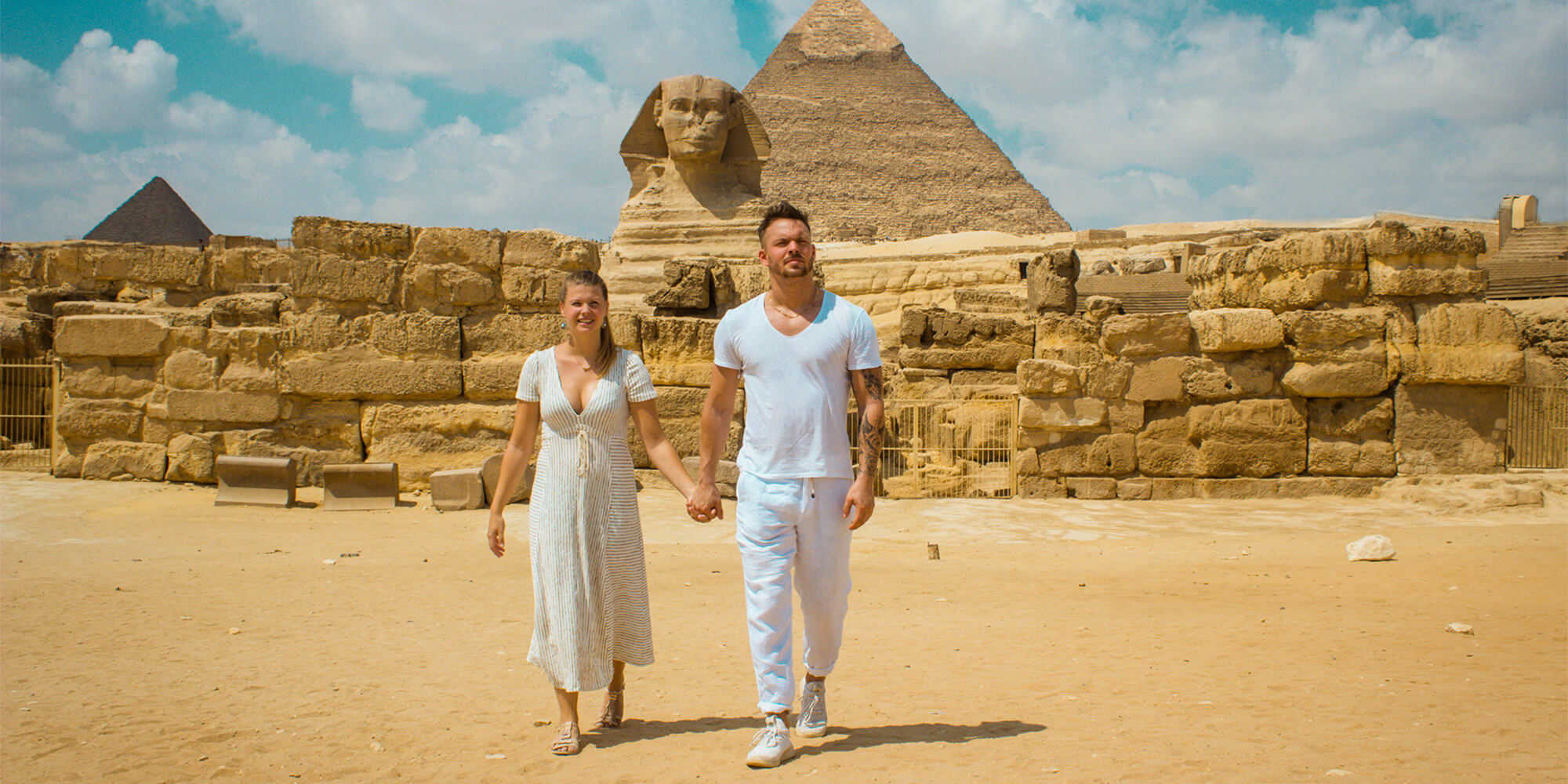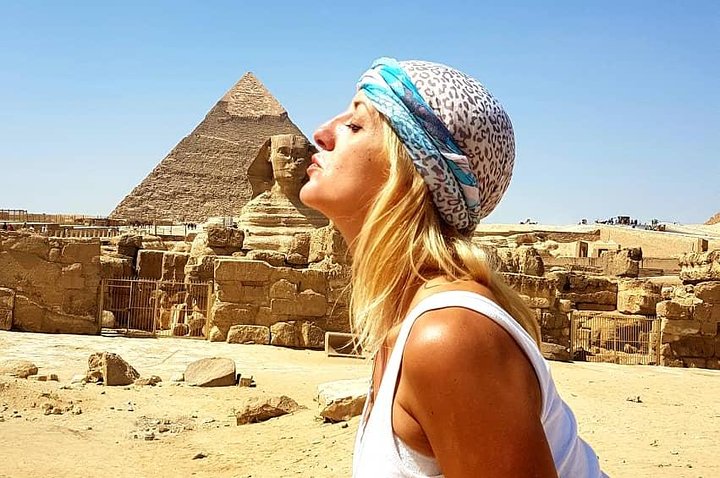Explore the ancient marvels of Egypt with a focus on Sakkara and the Giza Pyramids. Discover the Step Pyramid of Djoser and the iconic Giza Pyramids, including the Great Pyramid of Khufu, the Pyramid of Khafre, and the Pyramid of Menkaure. Learn about the rich history, architectural feats, and cultural significance of these timeless treasures. Perfect for history enthusiasts and world travelers alike.
Trip Highlights :
Embark on a leisurely private tour of Cairo’s top attractions, including the Giza Pyramids, the Sphinx, the Egyptian Museum, and Sakkara. Enjoy convenient pickup and drop-off from the airport or any hotel in Cairo or Giza.
Your day begins with a visit to the Giza Pyramids, where you’ll explore the Great Pyramid of King Cheops, as well as the pyramids of Chephren and Mycerinus. Capture unforgettable photos at the panoramic viewpoint showcasing all three pyramids. Next, visit the majestic Sphinx and the Valley Temple.
Continue your journey at the Egyptian Museum, home to the treasures of Tutankhamun, with an optional visit to the Mummy Room for those interested. After a delicious lunch at a local restaurant (vegetarian options available upon request), you’ll head to Sakkara to see the oldest pyramid, constructed around 2650 B.C. Here, you’ll learn about the fascinating history of the Step Pyramid.
At the end of your tour, you’ll be transferred back to your hotel in Cairo or Giza, filled with memories of Egypt’s incredible heritage.
Includes/Excludes
Trip Including
- Qualified tour guide Hotel pickup and drop off
- All transfers by air conditioned vehicle
- All taxes and service charges
- Entrance fees
Trip Excluding
- Any extras not mentioned above. Drinks in the Restaurant
- Any extras not mentioned in the Program
- Personal
- expenses
- Optional Activities.
- Single Traveller 86$
- From 2 – 3 Persons 46$ Per Person
- From 4 – 6 Persons 37$ Per Person
- From 7 – 10 Persons 33$ Per Person
Imprtant Note:
The prices depends on the number of participants, please send us a request, then we will make an offer with the exact price.
Children Policy
- Child From 0 – 6 years: free
- Child From 7 – 12 years old: 50% of the total tour cost for an adult
- All children over the age of 12 are considered adults.
Cancellation Policy
- We will charge a cancellation fee of 100% if booking is cancelled 1 day or less before the event
- We will charge a cancellation fee of 0% if booking is cancelled 100 days or less before the event
More Info
Overview
Discover the Ancient Wonders: A Tour of Sakkara and the Giza Pyramids
Egypt stands as a symbol of ancient grandeur, where timeless treasures beckon explorers from around the globe. The rich tapestry of history woven into Egypt’s landscape is best exemplified by two iconic landmarks: Sakkara and the Giza Pyramids. These ancient monuments not only spotlight the civilization’s exceptional architectural skills but also narrate stories of a culturally and spiritually rich era.
Sakkara, an immense necropolis in the ancient capital of Memphis, holds the distinction of being one of Egypt’s most significant archeological sites. It is here that the Step Pyramid of Djoser, conceived by the brilliant architect Imhotep, proudly stands as the world’s oldest monumental stone structure. Each layer of the pyramid offers insights into early engineering marvels and the transformative epochs of Egyptian art and architecture.
In contrast, the Giza Pyramids, situated on the Giza Plateau near Cairo, are illustrious for their grandeur and mystery. Comprising the Great Pyramid of Khufu, the Pyramid of Khafre, and the Pyramid of Menkaure, this triad represents an apex in ancient Egyptian pyramid-building techniques. They have incited fascination and scholarly debate alike, owing to their complex construction methodologies and the enigmatic Sphinx that guards them.
These majestic structures attest to a period when architectural innovation and cultural narratives were deeply intertwined. They provide an invaluable window into understanding the ethos, spiritual beliefs, and socio-political dynamics of ancient Egypt. Both Sakkara and the Giza Pyramids serve as keystones in the study of Egyptology, rendering them indispensable to any comprehensive tour of Egypt’s historical treasures.
The Historical Significance of Sakkara
Sakkara stands as one of Egypt’s most significant archaeological sites, serving as the vast necropolis for the ancient city of Memphis. This sprawling burial ground is remarkable not only for its size but also for its historical depth, extending roughly 7,000 years back into the realm of antiquity. At its heart lies the Step Pyramid of Djoser, a marvel of early engineering and a pivotal structure in the annals of pyramid construction. Conceived by the exceptional architect Imhotep, this edifice revolutionized the methods and design principles of pyramid building that dominated ancient Egyptian architecture.
Imhotep’s vision transformed the traditional mastaba, or flat-roofed structures, into a series of stacked tiers, culminating in the iconic step pyramid shape that reached approximately 60 meters in height. This innovation not only elevated the art of construction but also set a precedent for subsequent pyramid designs, including those found in Giza. The Step Pyramid of Djoser marks a significant leap in the engineering capabilities of the era, showcasing the advancement from simple tombs to more complex and grandiose structures.
Beyond the Step Pyramid, Sakkara hosts a trove of other remarkable tombs and monuments. Among these are the burial sites of various nobles and officials, each adorned with intricate carvings and vibrant wall paintings that offer rich insights into the religious beliefs and daily life of ancient Egyptians. The Mastaba of Ti and the Tomb of the Two Brothers stand out for their artful depictions and historical narratives. These sites underscore Sakkara’s importance not just as a burial ground, but also as a cultural and religious center.
In sum, a Sakkara tour offers an unparalleled journey through the early phases of pyramid construction and the intricate customs surrounding burial practices in ancient Egypt. As a precursor to the Giza pyramids, Sakkara’s monuments provide invaluable context, making it an essential stop for any well-rounded exploration of Egypt’s ancient wonders.
Exploring the Step Pyramid of Djoser
The Step Pyramid of Djoser, located in Sakkara, stands as a monumental testament to ancient Egyptian ingenuity and innovation. As the oldest stone-cut structure in the world, the Step Pyramid represents a significant leap in architectural advancement, transitioning from traditional mastaba tombs to the colossal pyramids that define Egypt’s skyline. Constructed during the 27th century BCE for Pharaoh Djoser by his architect, Imhotep, this pyramid is not only a marvel of engineering but also a symbol of divine kingship.
Consisting of six mastaba-like layers stacked atop one another, the pyramid rises to approximately 62 meters. Its terraced design signifies a departure from prior mortuary structures and introduces the monumental stone construction that would dominate subsequent pyramid building. The precision with which the massive limestone blocks were quarried and assembled indicates a profound understanding of engineering and labor organization. Additionally, the use of dressed stone in intricate patterns showcases aesthetic considerations alongside functional necessities.
Surrounding the Step Pyramid of Djoser is a complex that includes several significant architectural elements. The mortuary temple, positioned on the north side of the pyramid, served as the venue for ritual offerings dedicated to the king’s ka (spirit). This temple, along with the enclosure wall and various courtyards, amplifies the pyramid’s monumental presence. Among these, the Heb-sed Court stands out, an area replicating the ceremonial grounds used in celebrating the Heb-sed festival. A jubilee intended to renew the pharaoh’s strength, the precise replication of this court underscores the symbolic function embedded within the complex.
Understanding the Step Pyramid and its surrounding structures offers deep insight into ancient Egyptian religious and cultural values. It presents how early innovations in Sakkara paved the way for the grandeur of the Giza Pyramids, illustrating a fascinating chapter in the annals of human history.
Unveiling the Secrets of Sakkara’s Tombs
Sakkara, an expansive necropolis in ancient Egypt, offers a rich tapestry of history through its myriad tombs. Each tomb is adorned with artistic motifs and hieroglyphics that reveal much about the society, culture, and daily activities of the time. Among these, the tomb of Mereruka stands out as one of the largest and most elaborate. Mereruka, a high-ranking official during the reign of Pharaoh Teti, had his tomb painted with vivid reliefs that display scenes of daily life such as farming, hunting, and religious rituals.
Equally significant is the tomb of Kagemni, another nobleman whose final resting place features detailed depictions of social activities, including scenes of feasting and dancing. The intricate carvings and paintings in the tomb create a vivid tableau that transports visitors back to an era rich with tradition and ritual. These artifacts are crucial in understanding not only the funerary practices but also the broader sociopolitical structure of ancient Egyptian civilization.
The appeal of Sakkara extends beyond these two renowned tombs. The entire necropolis is dotted with tombs that tell stories through painted reliefs and hieroglyphics. These inscriptions often detail the deceased’s lineage, accomplishments, and offerings they were expected to receive in the afterlife. The walls of many tombs are canvases that celebrate the skills and artistry of ancient Egyptian craftsmen, their pigments surviving millennia to give us a window into an ancient world.
In addition to the artistic treasures within, the tombs serve as repositories of historical knowledge. Archeologists continue to uncover significant discoveries in Sakkara, contributing to a deeper understanding of the Old Kingdom period. The tombs, paintings, and carvings in Sakkara provide an invaluable glimpse into the complex interplay of daily life, religion, and governance that characterized ancient Egypt.
The Giza Pyramid Complex stands as an eternal testament to ancient Egypt’s architectural ingenuity and grandeur. This iconic site, recognized as one of the ancient wonders of the world, remains a focal point for historians, archaeologists, and tourists alike. Comprising three primary pyramids, this complex is a paramount representation of the Old Kingdom’s monumental legacy. These structures, namely, the Pyramid of Khufu (often referred to as the Great Pyramid), the Pyramid of Khafre, and the Pyramid of Menkaure, each bear unique historical significance and splendor.
Pyramid of Khufu
The Great Pyramid of Khufu, also known as the Pyramid of Cheops, claims the title of the largest among the three. Constructed during the Fourth Dynasty around 2580–2560 BC, this pyramid originally soared to a height of 146.6 meters (481 feet) and stood as the tallest human-made structure in the world for over 3,800 years. Built as a tomb for Pharaoh Khufu, this pyramid’s precise construction methods and alignment with celestial bodies continue to intrigue scholars, accentuating its status as an architectural marvel.
Pyramid of Khafre
The second notable pyramid in this triad is the Pyramid of Khafre, constructed for Pharaoh Khufu’s second son, Khafre. It is distinguishable by its association with the Great Sphinx, which stands guard nearby, adding a layer of mythic allure to the site. Although slightly smaller than the Great Pyramid, Khafre’s pyramid maintains a distinctive aesthetic, with some of the original casing stones still visible at its apex. This pyramid was built roughly during 2558–2532 BC and features a unique and elaborate internal structure, showcasing the evolution of pyramid construction techniques.
Pyramid of Menkaure
The third of the Giza Pyramids is the Pyramid of Menkaure, created for Pharaoh Menkaure and constructed circa 2510 BC. Though it is the smallest of the three main pyramids, standing at a height of 65 meters (213 feet), Menkaure’s monument is no less significant. It highlights the transition to more intricate burial complexes and includes substantial contributions to the surrounding mortuary temples and subsidiary pyramids. This pyramid’s detailed craftsmanship and the adjacent Queen’s pyramids reflect a shift towards more elaborate funerary practices.
Together, the Giza pyramids encapsulate the grandeur of the ancient Egyptian civilization and their architectural prowess. They serve not only as royal tombs but also as enduring symbols of the extraordinary human ambition to immortalize one’s legacy in stone. A visit to the Giza pyramid complex is more than just a step back in time; it is a profound journey into the hearts of one of humanity’s greatest civilizations.
The Great Pyramid of Khufu: A Marvel of Engineering
The Great Pyramid of Khufu, standing as the largest among the trio at Giza, continues to astound historians, engineers, and tourists alike. This monumental structure, estimated to have been built around 2580–2560 BC, is an exceptional testament to ancient Egyptian engineering prowess. Its sheer size and the precise execution of its complex design underscore the sophistication of its builders.
Construction employed millions of massive limestone blocks, some weighing several tons each. The alignment of the Great Pyramid is astonishingly precise, with its sides closely aligned to the four cardinal points. Despite limited technology, the Egyptians achieved this level of precision, a feat that prompts much admiration and speculation to this day.
Within the pyramid lies an intricate network of chambers and passageways. The King’s Chamber, centrally located within the structure, is particularly notable. Constructed from large blocks of granite, this chamber once housed a sarcophagus, believed to have contained the remains of Pharaoh Khufu. Equally impressive is the Grand Gallery, a sloped corridor that leads towards the King’s Chamber. This gallery measures approximately 47 meters in length and 8.6 meters in height, distinguished by its corbelled walls.
Multiple theories exist regarding how the Great Pyramid was constructed. Traditional views suggest the use of massive labor forces equipped with simple tools such as copper chisels and wooden sledges. Some researchers propose the utilization of ramps, either straight or spiral, to transport the limestone blocks to their destined heights. A more recent hypothesis speculates on an internal ramp that could have been used during construction, an idea that aligns with some internal structural anomalies discovered through modern scanning techniques.
Whether visiting via a dedicated Giza pyramids tour or incorporating it into a broader sakkara tour, standing before the Great Pyramid of Khufu offers an unparalleled glimpse into an epoch that continues to inspire and intrigue the modern world.
The Sphinx and Its Mysteries
The Great Sphinx of Giza stands as one of Egypt’s most enigmatic monuments. Located on the Giza Plateau, near the world-famous pyramids, this colossal sculpture continues to captivate historians, archaeologists, and tourists alike. Believed to have been constructed during the reign of Pharaoh Khafre, around 2500 BCE, the Great Sphinx is a testament to the ancient Egyptians’ architectural and artistic prowess.
One of the most striking features of the Sphinx is its unique combination of a lion’s body and a human head, thought to symbolize strength and wisdom. Carved from a single limestone ridge, it stretches to an impressive length of 73 meters and stands 20 meters tall. The head of the Sphinx, measuring 4 meters wide and 5 meters high, is believed to bear the likeness of Pharaoh Khafre himself, adding a personal touch to this monumental guardian of the Giza Pyramids.
The Great Sphinx has not only been a marvel of ancient engineering but also a subject of numerous theories regarding its purpose. Some scholars argue that it served a religious function, acting as a guardian of burial sites. Others suggest it was an astronomical marker, aligned with the rising sun during the equinoxes, thus symbolizing rebirth and immortality. Despite extensive research and debate, these theories still invite curiosity and speculation.
Besides its potential functions, the Great Sphinx also holds various secrets. Over the centuries, it has endured harsh weather conditions, leading to significant erosion and the loss of its original nose and beard. Restoration efforts have been ongoing, aiming to preserve this invaluable piece of history for future generations. Additionally, tales of hidden chambers and tunnels beneath the Sphinx fuel the imagination, although no concrete archaeological evidence has come to light yet.
The mysteries of the Great Sphinx of Giza remain a focal point for those embarking on a sakkara tour, providing an intriguing complement to the grandeur of the pyramids. As research continues, each discovery and theory sheds new light on this ancient wonder, keeping its allure alive for generations to come.
Touring Tips: Making the Most of Your Visit
Embarking on a sakkara tour and exploring the Giza Pyramids can be a remarkable experience, provided you plan well and observe a few practical guidelines. First and foremost, consider visiting these majestic sites during the early mornings or late afternoons. These times not only help you avoid the midday heat but also provide softer, more picturesque lighting for photography.
When planning your visit, hiring a knowledgeable tour guide can greatly enhance your experience. Guides can offer deeper insights into the historical significance and architectural marvels of the sites. Certified guides are available through reputable travel agencies and official tourism websites. It’s advisable to book your guide in advance, particularly during peak tourist seasons.
While packing for your tour, ensure you include essentials such as comfortable walking shoes to navigate the uneven terrain, plenty of water to stay hydrated, and sun protection like hats and sunscreen. Don’t forget a camera or smartphone to capture the breathtaking sights. Lightweight clothing is recommended, but remember to dress modestly as a sign of respect for the cultural norms of the area.
At Sakkara, make it a point to explore the Step Pyramid of Djoser, which stands as the oldest stone pyramid complex. Don’t miss the intricately decorated tombs of the Nobles, where vibrant wall carvings provide a glimpse into ancient Egyptian life. In contrast, at the Giza Pyramids, the Great Pyramid of Khufu, the Pyramid of Khafre, and the Pyramid of Menkaure are all must-see. Be sure to visit the iconic Sphinx, which guard the Giza Plateau with an enigmatic gaze.
Respect the heritage and sanctity of these ancient sites by not climbing the structures or touching the carvings. Always follow the instructions provided by your guide and adhere to the site regulations. Photography might be restricted in certain areas, so be mindful of signage and guidelines.
By planning thoughtfully and respectfully, your tour of Sakkara and the Giza Pyramids can be an enriching journey through history, architecture, and culture.




